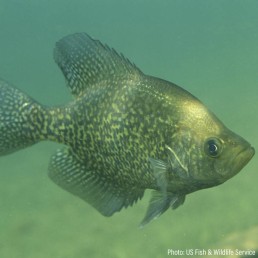Patterns and Techniques from Crappie Pros
SHARE THIS POST
Crappies are available in all 48 contiguous states along with Mexico and Canada. A minimal investment in gear is needed to catch crappies; something as simple as a pole, plain hook and minnow, or a jig and plastic imitation. You do not need a boat; even a shore fisherman can experience success if fishing at the right time of year and location. Being schooling fish, crappies, can be very cooperative and fun to catch once located.
Finally, crappies are great table fare and can be prepared in a variety of ways.
DVDs reveal crappie patterns
If you are new to crappie fishing or a veteran who would like to learn new techniques, you will enjoy these three DVDs from B‘n’M Poles of West Point, Miss. (www.b’n’mpoles.com). To my knowledge, B‘n’M offers the largest selection of poles and rods for crappies and other panfish.
These DVDs utilize tutorials, diagrams, and on-the-water footage to educate casual fishermen about the newest (and oldest) techniques of catching crappies in any conditions. Covering many different methods, these DVDs are professionally produced and edited by Russ Bailey, host of Brushpile Fishing TV show. Each segment includes diagrams, how-to, and three tips for each technique and is conducted with a different pro staffer from B‘n’M. Most are professional crappie tournament anglers and guides on some of the best crappie waters in the country. They are some of the most well-known and popular crappie fishermen in the business. These pros also discuss a wide variety of products and manufacturers, not just those from B‘n’M.
Sam Heaton is a renowned crappie expert. Ronnie Capps and Steve Coleman are national champions who have won many tournaments. Ray Scott, the late founder of the Bass Anglers Sportman Society (B.A.S.S.), also loved to fish for crappies. Then there are Jim Duckworth, a renowned guide from Tennessee; Richard Williams, a guide on Kentucky Lake; and Roger Gant, who guides on Pickwick Lake. They, along with many more, make up a formidable lineup of teachers.
Th DVDs are titled Any Time, Any Place, In Any Water—Crappie, Numbers 1, 2 and 3. DVD #1 is sold out, but the other two can be purchased for $6 each, or all three can be downloaded for free off the B‘n’M website.
DVD subject matter
DVD #1’s featured waters include Realfoot Lake in Tenn., Kentucky Lake, Patoka Lake in Ind., Sardis Lake in Miss., and Weiss Lake in Ala. The nine segments on this DVD feature methods for fishing aluminum boat lifts, winter (jig fishing) dock shooting, fishing standing timber, power trolling jigs, summer spider rigging live bait, summer crankbaits, bottom-bouncing and long-line trolling. Great tips offered in each segment include : winter ledges—work the drop-offs by points where the river channel makes a turn; power trolling rigs—describes and discusses the Kentucky Lake Rig and double-hook Capps and Coleman Rig; summer crankbaits—the best areas for summer crappies, and says that trolling crankbaits at 1.7 to 1.8 mph is overall the best speed; long-line trolling (jigs) in early spring, flat-line trolling jigs at .8 to 1.0 mph for best results.
Are you enjoying this post?
You can be among the first to get the latest info on where to go, what to use and how to use it!
DVD #2’s featured waters include Lake Neeley Henry, Grenada Lake, Green River Lake, Reelfoot Lake, Pickwick Lake, Weiss Lake, Lake Kincaid, Rend Lake and Beaver Lake. The ten segments on this DVD highlight the following: shallow-water trolling, Grenada summer timber; Grenada crankbait patterns; Green River summer patterns; spider-rigging with floats; side pulling; fall dock shooting techniques; deep-water winter bottom bouncing; ice-out stake beds; and laydown patterns.
A few of the tips that I took from this DVD contain: Green River summer patterns—fish the flats close to the river channels and fish above the summer thermocline; side pulling—maintain a 45-degree angle on your lines while side pulling and moving slowly; ice-out stake beds—shallow water stake beds hold fish right after ice-out, and stay close to the bottom; use scent products and downsize jigs; laydown patterns—fish laydowns from different angles.
Featured waters in DVD #3 include Reelfoot Lake, Rend Lake, Lake Okeechobee, Lake of the Ozarks, Ross Barnett Reservoir, Beaver Lake and Kentucky Lake. The nine special segments contain fall transition crappies; fall bridges; Okeechobee weeds; winter stick baits; winter long-line trolling; spawning crappies—deep and shallow; casting for crappies with the buffet rig; and fishing the bushes for summer bluegills.
Some tips that caught my attention include: bridge fishing—look for shad schools and fish one foot off bottom where rocks meet mud or sand; Okeechobee weeds—look for weed bed points and vertical fish the small holes in the weed patches and the open-water paths between them; winter stick baits—trigger reaction bites with small, suspending jerk baits in clear water; spawning crappies—start deep and work shallower on deep water stumps; fish weeds as they extend out from shoreline shallows; and try the first drop-off outside weeds after a cold front.
These are just a few of the highlights found in the three DVDs, which will make you a better crappie angler. The pros cover several techniques that could be new to crappie anglers in the North Country and will add to your enjoyment and productivity this season.
Looking for some new fishing techniques to try this season? You’ll find plenty of suggestions in every issue of MidWest Outdoors. Subscribe on our website.
MWO
SHARE THIS POST
You may also like...
Nothing found.
Did you enjoy this post?
You can be among the first to get the latest info on where to go, what to use and how to use it!
Bill Takacs
Bill Takacs of Hammond, Ind., has been writing for MidWest Outdoors regularly since 1975, and has been published in several state, regional and national publications. He fishes for virtually every freshwater fish from panfish to muskies, with the exceptions of sturgeon and alligator gar.
